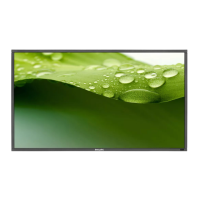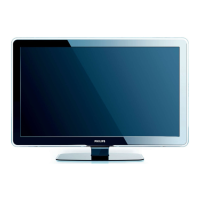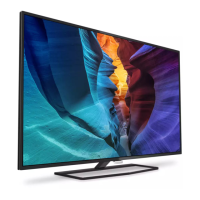Do you have a question about the Philips BFL2114/27 Series and is the answer not in the manual?
Copyright and specification change notices.
Information on obtaining technical support and resources from Philips.
Details on master and guest remote controls required for operation.
Description of the primary remote controls for TV operation.
Description of secondary remote controls for guest use.
Overview of various optional accessory remote controls available.
Procedures for configuring different types of remote controls.
Step-by-step guide for setting up the Master Remote Control.
Instructions for enabling multi-RC functionality for guest remotes.
Steps to restore a guest remote control to its original settings.
Configuration guide for the Healthcare Remote Control.
Configuration guide for the Easy Remote Control.
Identifying the TV's initial 'out of the box' state.
How to check, enable, or disable Professional Mode for advanced settings.
Accessing and utilizing the Customer Service Menu for TV information.
Step-by-step guide for manually reinstalling the TV's software and settings.
Automating TV reinstallation using a script within a clone file.
Overview of the Instant Initial Cloning process for mass deployment.
Performing the initial setup using the IIC wizard.
Combining IIC with software updates for initial setup.
Configuring key settings during the initial TV setup wizard.
General overview of the Professional Settings section.
How to save and apply changes made within the Professional Settings.
Understanding the concept and requirements of a professional session.
Steps for exiting the professional menu after app installations.
A general overview of the available professional settings.
Managing software upgrades and cloning TV configurations.
Configuring settings that apply when the TV powers on.
Settings related to channels that are active on TV startup.
Settings for features that launch automatically on TV startup.
Configuring default sound settings active on TV startup.
Configuring default picture settings active on TV startup.
Settings for default closed caption display on startup.
Managing settings specific to guest use and profiles.
Configuring content rating restrictions and PIN codes.
Setting the default frequency for the TV's Wi-Fi hotspot.
Configuring settings to identify the TV within a network or system.
Assigning a unique ID to the room for identification purposes.
Setting a custom name for the premises where the TV is installed.
Setting the Geonames ID for location-based weather services.
Defining the name displayed for the TV on other devices.
Details for identifying the installer or system integrator.
Comprehensive management of guest profiles and settings.
Customizing the TV's main dashboard interface.
Overview and management of various TV features.
Managing installed applications, including configuration and profiles.
Configuring and using the SmartInfo feature for displaying information.
Enabling and configuring content sharing features like Chromecast and hotspots.
Enabling or disabling the display of weather information.
Customizing the welcome screen and screensaver appearance.
Configuring content rating restrictions and PIN codes.
Configuring the display and format of the clock.
Setting up scheduled events and actions for the TV.
Configuring and displaying custom banners on the TV.
Configuring the TalkBack accessibility feature for audio feedback.
Managing channel lists, including display and filtering options.
Managing and configuring available input sources.
Setting the TV's date, time, and timezone.
Configuring network connections and wireless settings.
Step-by-step guide for connecting the TV to a network.
Detailed configuration options for network connections.
Controlling the TV over IP using web services and CMND.
Managing input devices and locking controls.
Accessing and configuring advanced system settings.
Adjusting core picture and sound settings.
Detailed settings for picture quality adjustments.
Detailed settings for audio output and sound profiles.
Configuring accessibility features for enhanced user experience.
Accessing and modifying settings related to the Android OS.
Options for resetting TV settings to default or clearing data.
Customizing the TV's main dashboard interface and appearance.
Control over the visibility of the 'Manage Account' icon.
Control over the visibility of the 'Click to speak' assistant icon.
Configuring which apps and content appear in the Recommended section.
Adjusting the overall look and feel of the TV's menu interface.
Managing installed applications, including installation and profile configuration.
Wizard to guide through the configuration and management of TV apps.
Steps for installing applications from the Google Play Store.
Remote management of apps via the AppControl web portal.
Configuring the welcome screen and screensaver settings.
Setting up and managing the TV's screensaver.
Customizing the content and background of the welcome screen.
Setting up scheduled events and actions for the TV.
Tools for renaming, reordering, hiding, and managing channels.
Procedure for renaming individual TV channels.
Options to hide or show channels in the channel list.
Changing the sequence of channels in the list.
Blanking or unblanking channels to hide video and audio.
Deleting channels from the TV's channel list.
Renumbering channels to effectively reorder them.
Wizard for installing and tuning TV channels.
Process for installing channels received via RF signals.
Installing Over-The-Top and TIF channels via apps.
Installing IP-based channels using a provided list.
Adding local files as media channels.
Step-by-step process for connecting the TV to a network.
Wizard for configuring the Crestron control system integration.
Configuring display-related settings for Crestron control.
Setting up SSL for secure connections with Crestron systems.
Enabling automatic discovery of Crestron devices on the network.
Setting parameters for Crestron virtual controllers and devices.
Configuring Room View software for integration.
Enabling cloud-based integration for Crestron systems.
Functionality and purpose of buttons within the Crestron application.
Understanding limitations of the TV when integrating with Crestron.
Details on cloning configurations for Crestron setups.
Display of recommended content, channels, and apps in the user menu.
Viewing the list of installed channels within the user menu.
Functionality for casting content from external devices to the TV.
Explanation of the Chromecast built-in platform and its capabilities.
Professional implementation strategies for Chromecast on TVs.
Setting up Chromecast for complete TV control by the user.
Installer-managed backend solutions for Chromecast network setup.
Prerequisites and requirements for optimal Chromecast performance.
Understanding the network traffic impact of casting features.
Viewing and displaying installed applications in the user menu.
Accessing additional settings and features not listed in main categories.
User-accessible settings for picture, sound, and language.
User access to features like alarm, weather, and hotspot.
Enabling and configuring the TV's internet hotspot functionality.
Displaying current weather information on the TV.
Configuring the TalkBack accessibility feature for audio feedback.
Managing personal accounts, login, and clearing user data.
Information about icons displayed in the TV's top status bar.
Logging into a personal Google account for personalized experience.
Setting an alarm with specific time and channel preferences.
Accessing the weather forecast screen from the top icons.
Changing the language displayed in the TV's user menus.
Configuring and displaying custom information pages.
Using SmartInfo as an HTML5 browser for custom content.
Using a custom application for SmartInfo content display.
Recommended setup procedures and limitations for IPTV.
Specific professional settings required for IPTV installation.
Procedure for adding IP channels using a channel list file.
Using DOCSIS cable infrastructure for IP network distribution.
Connecting the TV to a CMND server using its IP address.
Modifying TV settings, specifically the Server URL, for CMND.
Utilizing a DNS server to redirect TV connections to the CMND server.
How the TV searches for the CMND server using fallback URLs.
Connecting the TV to a CMND server using RF signals.
Developing custom dashboards using web technologies.
Developing custom dashboards using Android applications.
Adding custom logos to TV channels.
Procedure for extracting existing channel logos from the TV.
Steps for manually adding custom channel logos.
Troubleshooting issues with improperly scaled channel logos.
Understanding and editing the ChannelList.xml file for channel configurations.
Manually adding RF channels by editing ChannelList.xml.
Adding media channels by editing ChannelList.xml.
Manually adding IP channels by editing ChannelList.xml.
Using RoomSpecificSettings for automated TV cloning and configuration.
Implementing custom dashboards stored locally on the TV.
Customizing the Terms & Conditions displayed for hotspot usage.
Procedure for capturing TV logs onto a USB drive for technical support.











